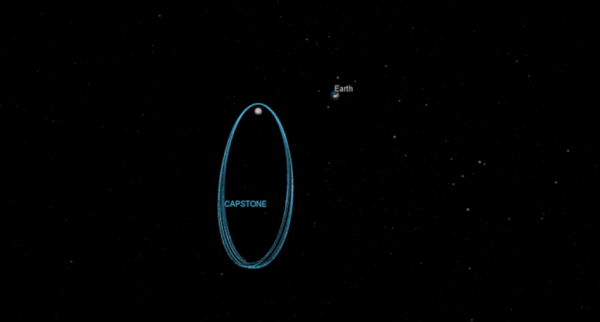Watch NASA's CAPSTONE cubesat launch to the moon today to test unique lunar orbit
The microwave-sized CAPSTONE will test a new orbit for NASA's Gateway space station around the moon.
Update for June 28: Rocket Lab successfully launched NASA's CAPSTONE cubesat toward the moon on June 28 at 5:55 a.m. EDT (0955 GMT). Read our full wrap story and see launch video.
After months of delays, NASA's next mission to the moon is finally ready to launch.
Early Tuesday (June 28), Rocket Lab will launch NASA's small CAPSTONE cubesat to the moon from New Zealand on an Electron booster and you can watch it live online. Liftoff is at 5:55 a.m. EDT (0955 GMT), with NASA's broadcast beginning in the window above at 5 a.m. EDT (0900 GMT).
CAPSTONE, short for Cislunar Autonomous Positioning System Technology Operations and Navigation Experiment, is a 55-pound (25 kilograms) cubesat the size of a microwave oven designed to test what scientists call a near-rectilinear halo orbit around the moon.
"It will be launching to deliver the first spacecraft that demonstrates the unique lunar orbit intended for NASA's Gateway," said Chris Baker of NASA's Space Technology Mission Directorate, referring to the planned Gateway station at the moon for future Artemis program astronauts. (NASA hopes to return astronauts to the moon in the mid-2020s using its Orion spacecraft, new megarockets and private lunar landers.)
Related: NASA's CAPSTONE moon mission to go where no cubesat has gone before
A new orbit at the moon
CAPSTONE's looping near rectilinear halo orbit, called NRHO for short, will bring the cubesat within 1,000 miles (1,600 kilometers) of the moon at its closest point and reach as far out as 43,500 miles (70,000 km). It will allow the spacecraft to always face the Earth for uninterrupted communications and help plan for science observations both near the moon and high above it.
Get the Space.com Newsletter
Breaking space news, the latest updates on rocket launches, skywatching events and more!

"We view the CAPSTONE mission as a whole as a valuable precursor not just for Gateway, which we've talked a lot about for CAPSTONE, but also for Orion and the human landing system and the larger architecture," said Nujoud Merancy, NASA's chief of the exploration mission planning office at the Johnson Space Center in Houston, said in the May briefing. "NRHO enables global lunar access, in particular the lunar south pole, which is what we're interested in for the Artemis campaign."
CAPSTONE is expected to take four months to reach the moon (mark your calendars for Nov. 13) and then at least six months testing out its unique orbit for NASA. During that time, it will perform a series of navigation and communications tests, some of them with NASA's Lunar Reconnaissance Orbiter, which has been orbiting the moon since 2009.

NASA originally hoped to launch the mission in 2021 but delays associated with COVID-19 pandemic pushed it into 2022, with the need for additional checks on the spacecraft and rocket further delaying the mission. The $30 million mission ($10 million for the spacecraft and $20 million for the rocket) is overseen by the company Advanced Space of Colorado, with Terran Orbital's Tyvak Nano-Satellite Systems of California building the cubesat.
A deep-space first for Rocket Lab

CAPSTONE's voyage to the moon will mark a first for Rocket Lab, the company's first deep-space mission beyond low Earth orbit. It will use the company's Photon kick stage to send the cubesat on its way.
"We're super excited to see it on the pad and can't wait to give it a safe launch and off to the moon," Rocket Lab CEO Peter Beck said May 25.
Rocket Lab is planning its own mission to Venus using Electron boosters and Photon, making CAPSTONE a dry-run of sorts for that flight.
"This really lays the groundwork for future deep-space missions," Beck said.

The months-long trip to the moon for CAPSTONE is a result of using the relatively low-cost, fuel efficient approach with Rocket Lab's Photon, NASA officials have said, and isn't one astronauts will have to face on Artemis missions to Gateway. The cubesat should separate from the Photon stage about six days into the flight, NASA has said.
"When we travel to this orbit with a crew in Artemis, it would be as few as five days, potentially up to 10," Merancy said.
While it may take CAPSTONE a bit longer to reach the moon than Artemis astronauts, it will carry a small camera to snap photos of what it can see.
"We do have a payload imager on board," said CAPSTONE principal investigator Bradley Cheetham, CEO of Advanced Space, adding that the camera isn't part of cubesat's core orbit demonstration mission. "Why would you go to the moon without a camera? So we're looking forward to that."
Editor's note: Tune in on Tuesday , June 28, at 5 a.m. EDT (0900 GMT) to watch NASA's CAPSTONE mission launch to the moon on a Rocket Lab Electron booster. Liftoff is at 5:55 a.m. EDT (0955 GMT). This story was updated to include the new launch date and time for CAPSTONE.
Correction: An earlier version of this story had the incorrect date of CAPSTONE's arrival in lunar orbit. It is Nov. 13, not Oct. 15.
Email Tariq Malik at tmalik@space.com or follow him @tariqjmalik. Follow us @Spacedotcom, Facebook and Instagram.
Join our Space Forums to keep talking space on the latest missions, night sky and more! And if you have a news tip, correction or comment, let us know at: community@space.com.

Tariq is the Editor-in-Chief of Space.com and joined the team in 2001, first as an intern and staff writer, and later as an editor. He covers human spaceflight, exploration and space science, as well as skywatching and entertainment. He became Space.com's Managing Editor in 2009 and Editor-in-Chief in 2019. Before joining Space.com, Tariq was a staff reporter for The Los Angeles Times covering education and city beats in La Habra, Fullerton and Huntington Beach. In October 2022, Tariq received the Harry Kolcum Award for excellence in space reporting from the National Space Club Florida Committee. He is also an Eagle Scout (yes, he has the Space Exploration merit badge) and went to Space Camp four times as a kid and a fifth time as an adult. He has journalism degrees from the University of Southern California and New York University. You can find Tariq at Space.com and as the co-host to the This Week In Space podcast with space historian Rod Pyle on the TWiT network. To see his latest project, you can follow Tariq on Twitter @tariqjmalik.
